Study on the Influence of Temperature on the Temporal and Spatial Distribution Characteristics of Natural Cavitating Flow around a Vehicle
Abstract
:1. Introduction
2. Mathematical Formulations and Numerical Methods
2.1. Governing Equations
2.2. Detached-Eddy Simulation Model
2.3. Schnerr–Sauer Cavitation Model
2.4. Numerical Setup
2.5. Numerical Method Validation
3. Results and Discussion
3.1. Cavity Evolution and Pressure Pulsation
3.2. Vortex Structure Characteristics
3.3. Analysis of Turbulence Intensity and Integral Scale
4. Conclusions
- (1)
- The temperature affects the evolution of the cavity. Lower temperatures make the cavity unstable and increase the pressure pulsations inside the cavity, and also enhance the pressure pulsations where the cavity collapses. The cavity shedding frequency increases at lower temperatures, and the shedding cycle shortens. The cavity shedding size decreases, and the average volume of the cavity decreases. Additionally, the peak volume fluctuation increases, and the volume vibration amplitude becomes larger. This study also found that temperature changes have little effect on resistance.
- (2)
- The temperature changes the vortex structure. At lower temperatures, during the cavity development stage, a larger number of linear vortex structures appear in the model wake area, and the vortex structure is significantly stronger than under higher-temperature conditions. In the cavity stabilization stage, a lower temperature enlarges the vortex structure inside the cavity, thus accelerating the shedding of the cavity and shortening the cavity shedding cycle. Finally, in the cavity shedding stage, lower temperatures enhance the model wall vortex structure. In general, we found that the wake field vortex structure changes more drastically at the lower temperature.
- (3)
- The temperature affects the velocity pulsations around the model. At lower temperatures, the velocity pulsations are reduced, and this has a more significant impact on the wake flow field than the flow field inside the cavity. The lower temperature increases the turbulence dissipation rate and reduces the overall turbulence. At the same time, lower temperatures reduce the turbulence integral scale both outside and inside the cavity. The influence on the tail flow field is mainly concentrated on the two sides of the model tail, that is, the cavity moves downstream, and large-scale shedding becomes small-scale shedding.
Author Contributions
Funding
Informed Consent Statement
Data Availability Statement
Conflicts of Interest
References
- Batchelor, C.K.; Batchelor, G.K. An Introduction to Fluid Dynamics; Cambridge University Press: Cambridge, UK, 2000. [Google Scholar]
- Peng, C.; Tian, S.; Li, G.; Sukop, M.C. Simulation of multiple cavitation bubbles interaction with single-component multiphase Lattice Boltzmann method. Int. J. Heat Mass Transf. 2019, 137, 301–317. [Google Scholar] [CrossRef]
- Sun, T.-Z.; Zong, Z.; Zou, L.; Wei, Y.; Jiang, Y. Numerical investigation of unsteady sheet/cloud cavitation over a hydrofoil in thermo-sensitive fluid. J. Hydrodyn. 2017, 29, 987–999. [Google Scholar] [CrossRef]
- Wang, Y.; Xu, C.; Wu, X.; Huang, C.; Wu, X. Ventilated cloud cavitating flow around a blunt body close to the free surface. Phys. Rev. Fluids 2017, 2, 084303. [Google Scholar] [CrossRef]
- Pendar, M.-R.; Roohi, E. Cavitation characteristics around a sphere: An LES investigation. Int. J. Multiph. Flow 2018, 98, 1–23. [Google Scholar] [CrossRef]
- Liu, M.; Tan, L.; Cao, S. Cavitation–Vortex–Turbulence Interaction and One-Dimensional Model Prediction of Pressure for Hydrofoil ALE15 by Large Eddy Simulation. J. Fluids Eng. 2018, 141, 021103. [Google Scholar] [CrossRef]
- Sun, T.; Xie, Q.; Zou, L.; Wang, H.; Xu, C. Numerical investigation of unsteady cavitation dynamics over a naca66 hydrofoil near a free surface. J. Mar. Sci. Eng. 2020, 8, 341. [Google Scholar] [CrossRef]
- Yang, D.; Xiong, Y.; Guo, X. Drag reduction of a rapid vehicle in supercavitating flow. Int. J. Nav. Arch. Ocean Eng. 2017, 9, 35–44. [Google Scholar] [CrossRef] [Green Version]
- Akbari, M.A.; Mohammadi, J.; Fereidooni, J. A dynamic study of the high-speed oblique water entry of a stepped cylindrical-cone projectile. J. Braz. Soc. Mech. Sci. Eng. 2021, 43, 1–15. [Google Scholar] [CrossRef]
- Huang, B.; Qiu, S.-C.; Li, X.-B.; Wu, Q.; Wang, G.-Y. A review of transient flow structure and unsteady mechanism of cavitating flow. J. Hydrodyn. 2019, 31, 429–444. [Google Scholar] [CrossRef]
- Knapp, R.T. Recent investigations of the mechanics of cavitation and cavitation damage. Wear 1958, 1, 455. [Google Scholar] [CrossRef]
- Reisman, G.E.; Wang, Y.-C.; Brennen, C.E. Observations of shock waves in cloud cavitation. J. Fluid Mech. 1998, 355, 255–283. [Google Scholar] [CrossRef] [Green Version]
- Passandideh-Fard, M.; Roohi, E. Transient simulations of cavitating flows using a modified volume-of-fluid (VOF) technique. Int. J. Comput. Fluid Dyn. 2008, 22, 97–114. [Google Scholar] [CrossRef]
- Ganesh, H.; Mäkiharju, S.A.; Ceccio, S.L. Bubbly shock propagation as a mechanism for sheet-to-cloud transition of partial cavities. J. Fluid Mech. 2016, 802, 37–78. [Google Scholar] [CrossRef] [Green Version]
- Philipp, A.; Lauterborn, W. Cavitation erosion by single laser-produced bubbles. J. Fluid Mech. 1998, 361, 75–116. [Google Scholar] [CrossRef]
- Arndt, R.E. Cavitation in vortical flows. Annu. Rev. Fluid Mech. 2002, 34, 143–175. [Google Scholar] [CrossRef]
- Yuan, C.; Song, J.; Zhu, L.; Liu, M. Numerical investigation on cavitating jet inside a poppet valve with special emphasis on cavitation-vortex interaction. Int. J. Heat Mass Transf. 2019, 141, 1009–1024. [Google Scholar] [CrossRef]
- Wang, C.-C.; Huang, B.; Wang, G.-Y.; Duan, Z.-P.; Ji, B. Numerical simulation of transient turbulent cavitating flows with special emphasis on shock wave dynamics considering the water/vapor compressibility. J. Hydrodyn. 2018, 30, 573–591. [Google Scholar] [CrossRef]
- Ji, B.; Ji, B.; Arndt, R.E.; Wu, Y. Numerical simulation of three dimensional cavitation shedding dynamics with special emphasis on cavitation–vortex interaction. Ocean Eng. 2014, 87, 64–77. [Google Scholar] [CrossRef]
- De Giorgi, M.G.; Fontanarosa, D.; Ficarella, A. Characterization of unsteady cavitating flow regimes around a hydrofoil, based on an extended schnerr–sauer model coupled with a nucleation model—sciencedirect. Int. J. Multiph. Flow 2019, 115, 158–180. [Google Scholar] [CrossRef]
- Kadivar, E.; Timoshevskiy, M.V.; Pervunin, K.S.; El Moctar, O. Experimental and numerical study of the cavitation surge passive control around a semi-circular leading-edge flat plate. J. Mar. Sci. Technol. 2020, 25, 1010–1023. [Google Scholar] [CrossRef]
- Timoshevskiy, M.V.; Ilyushin, B.B.; Pervunin, K.S. Statistical structure of the velocity field in cavitating flow around a 2D hydrofoil. Int. J. Heat Fluid Flow 2020, 85, 108646. [Google Scholar] [CrossRef]
- Sun, T.; Ma, X.; Wei, Y.; Wang, C. Computational modeling of cavitating flows in liquid nitrogen by an extended transport-based cavitation model. Sci. China Ser. E: Technol. Sci. 2016, 59, 337–346. [Google Scholar] [CrossRef]
- Chen, T.; Huang, B.; Wang, G.-Y.; Zhao, X. Numerical study of cavitating flows in a wide range of water temperatures with special emphasis on two typical cavitation dynamics. Int. J. Heat Mass Transf. 2016, 101, 886–900. [Google Scholar] [CrossRef]
- Holl, J.W.; Billet, M.L.; Weir, D.S. Thermodynamic effects on developed cavitation. J. Fluids Eng. 1975, 97, 507. [Google Scholar] [CrossRef]
- Cervone, A.; Bramanti, C.; Rapposelli, E.; D’Agostino, L. Thermal Cavitation Experiments on a NACA 0015 Hydrofoil. J. Fluids Eng. 2005, 128, 326–331. [Google Scholar] [CrossRef]
- Franc, J.-P.; Rebattet, C.; Coulon, A. An Experimental Investigation of Thermal Effects in a Cavitating Inducer. J. Fluids Eng. 2004, 126, 716–723. [Google Scholar] [CrossRef]
- Petkovšek, M.; Dular, M. Experimental study of the thermodynamic effect in a cavitating flow on a simple Venturi geometry. J. Phys. Conf. Ser. 2015, 656, 012179. [Google Scholar] [CrossRef] [Green Version]
- Chen, T.; Huang, B.; Wang, G.; Zhang, H.; Wang, Y. Numerical investigation of thermo-sensitive cavitating flows in a wide range of free-stream temperatures and velocities in fluoroketone. Int. J. Heat Mass Transf. 2017, 112, 125–136. [Google Scholar] [CrossRef]
- Sun, T.; Wei, Y.; Zou, L.; Jiang, Y.; Xu, C.; Zong, Z. Numerical investigation on the unsteady cavitation shedding dynamics over a hydrofoil in thermo-sensitive fluid. Int. J. Multiph. Flow 2019, 111, 82–100. [Google Scholar] [CrossRef]
- Wang, C.; Wang, G.; Huang, B. Characteristics and dynamics of compressible cavitating flows with special emphasis on com-pressibility effects. Int. J. Multiph. Flow 2020, 130, 103357. [Google Scholar] [CrossRef]
- Coutier-Delgosha, O.; Reboud, J.L.; Delannoy, Y. Numerical simulation of the unsteady behaviour of cavitating flows. Int. J. Numer. Methods Fluids. 2003, 42, 527–548. [Google Scholar]
- Wu, J.; Wang, G.; Shyy, W. Time-dependent turbulent cavitating flow computations with interfacial transport and filter-based models. Int. J. Numer. Methods Fluids 2005, 49, 739–761. [Google Scholar] [CrossRef]
- Zahiri, A.P.; Roohi, E. Anisotropic minimum-dissipation (amd) subgrid-scale model implemented in openfoam: Verification and assessment in single-phase and multi-phase flows. Comput Fluids 2018, 180, 190–205. [Google Scholar] [CrossRef]
- Chen, Y.; Li, J.; Gong, Z.; Chen, X.; Lu, C. Large eddy simulation and investigation on the laminar-turbulent transition and turbulence-cavitation interaction in the cavitating flow around hydrofoil. Int. J. Multiph. Flow 2019, 112, 300–322. [Google Scholar] [CrossRef]
- An, H.; Sun, P.; Ren, H.; Hu, Z. CFD-based numerical study on the ventilated supercavitating flow of the surface vehicle. Ocean Eng. 2020, 214, 107726. [Google Scholar] [CrossRef]
- Huang, B.; Young, Y.L.; Wang, G.; Shyy, W.; Huang, B. Combined Experimental and Computational Investigation of Unsteady Structure of Sheet/Cloud Cavitation. J. Fluids Eng. 2013, 135, 071301. [Google Scholar] [CrossRef]
- Long, X.; Cheng, H.; Ji, B.; Arndt, R.E.; Peng, X. Large eddy simulation and Euler–Lagrangian coupling investigation of the transient cavitating turbulent flow around a twisted hydrofoil. Int. J. Multiph. Flow 2018, 100, 41–56. [Google Scholar] [CrossRef]
- Sun, T.; Zhang, X.; Xu, C.; Zhang, G.; Wang, C.; Zong, Z. Experimental investigation on the cavity evolution and dynamics with special emphasis on the development stage of ventilated partial cavitating flow. Ocean Eng. 2019, 187, 106140. [Google Scholar] [CrossRef]
- Sun, T.; Wang, Z.; Zou, L.; Wang, H. Numerical investigation of positive effects of ventilated cavitation around a NACA66 hydrofoil. Ocean Eng. 2020, 197, 106831. [Google Scholar] [CrossRef]
- Huang, R.-F.; Du, T.-Z.; Wang, Y.-W.; Huang, C.-G. Numerical investigations of the transient cavitating vortical flow structures over a flexible NACA66 hydrofoil. J. Hydrodyn. 2020, 32, 865–878. [Google Scholar] [CrossRef]
- Ji, B.; Luo, X.; Arndt, R.E.; Peng, X.; Wu, Y. Large Eddy Simulation and theoretical investigations of the transient cavitating vortical flow structure around a NACA66 hydrofoil. Int. J. Multiph. Flow 2015, 68, 121–134. [Google Scholar] [CrossRef] [Green Version]
- Lidtke, A.K.; Humphrey, V.F.; Turnock, S.R. Feasibility study into a computational approach for marine propeller noise and cavitation modelling. Ocean Eng. 2016, 120, 152–159. [Google Scholar] [CrossRef] [Green Version]
- Kunz, R.F.; Lindau, J.W.; Kaday, T.A. Unsteady RANS and detached eddy simulations of cavitating flow over a hydrofoil. In Proceedings of the Fifth International Symposium on Cavitation, Osaka, Japan, 1–4 November 2003. [Google Scholar]
- Girimaji, S.S. Partially-Averaged Navier-Stokes Model for Turbulence: A Reynolds-Averaged Navier-Stokes to Direct Numerical Simulation Bridging Method. J. Appl. Mech. 2006, 73, 413–421. [Google Scholar] [CrossRef]
- Gao, G.H.; Zhao, J.; Ma, F.; Luo, W.D. Hybrid RANS–LES Modeling for Unsteady Cavitating Flow Simulation. Appl. Mech. Mater. 2012, 152, 1187–1190. [Google Scholar] [CrossRef]
- Usta, O.; Korkut, E.A. study for cavitating flow analysis using DES model. Ocean Eng. 2018, 160, 397–411. [Google Scholar] [CrossRef]
- Spalart, P.R. Comments on the feasibility of LES for wings, and on a hybrid RANS/LES approach. In Proceedings of First AFOSR International Conference on DNS/LES; Greyden Press: Dayton, OH, USA, 1997. [Google Scholar]
- Menter, F.R.; Kuntz, M.; Langtry, R. Ten years of industrial experience with the SST turbulence model. Turbulence Heat Mass Transf. 2003, 4, 625–632. [Google Scholar]
- Rayleigh, L. VIII. On the pressure developed in a liquid during the collapse of a spherical cavity. Lond. Edinb. Dublin Philos. Mag. J. Sci. 1917, 34, 94–98. [Google Scholar] [CrossRef]
- Plesset, M.S. The Dynamics of Cavitation Bubbles. J. Appl. Mech. 1949, 16, 277–282. [Google Scholar] [CrossRef]
- Schnerr, G.H.; Sauer, J. Physical and numerical modeling of unsteady cavitation dynamics. In Proceedings of the Fourth International Conference on Multiphase Flow, New Orleans, LA, USA, 27 May–1 June 2001. [Google Scholar]
- Brennen, C.E. Cavitation and Bubble Dynamics; Cambridge University Press (CUP): New York, NY, USA, 2014. [Google Scholar]
- Zhang, X.; Wang, C.; Wei, Y.; Sun, T. Experimental investigation of unsteady characteristics of ventilated cavitation flow around an under-water vehicle. Adv. Mech. Eng. 2016, 8. [Google Scholar] [CrossRef] [Green Version]
- Liu, C.; Wang, Y.; Yang, Y.; Duan, Z. New omega vortex identification method. Sci. China Ser. G: Physics, Mech. Astron. 2016, 59, 1–9. [Google Scholar] [CrossRef]
- Piomelli, U.; Balint, J.-L.; Wallace, J.M. On the validity of Taylor’s hypothesis for wall-bounded flows. Phys. Fluids A: Fluid Dyn. 1989, 1, 609–611. [Google Scholar] [CrossRef]





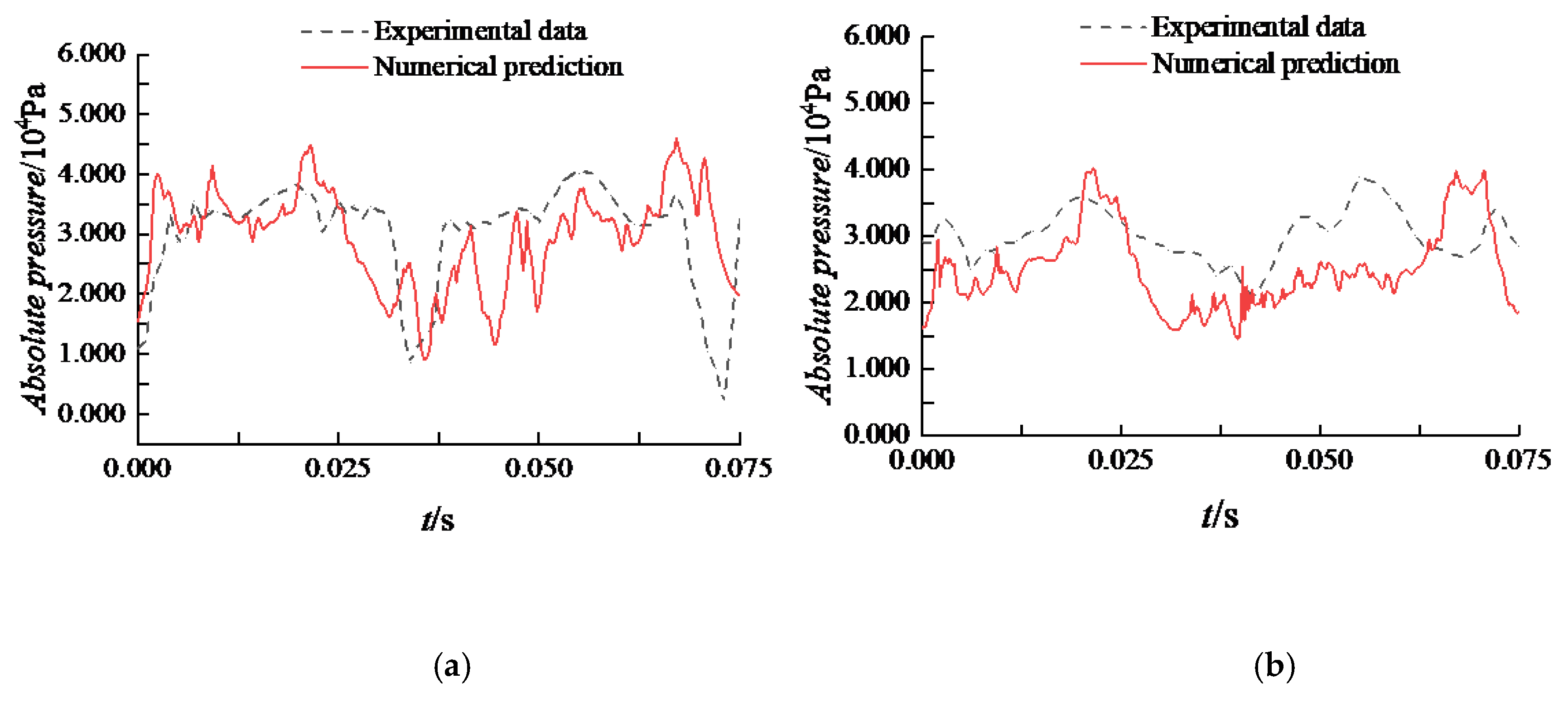
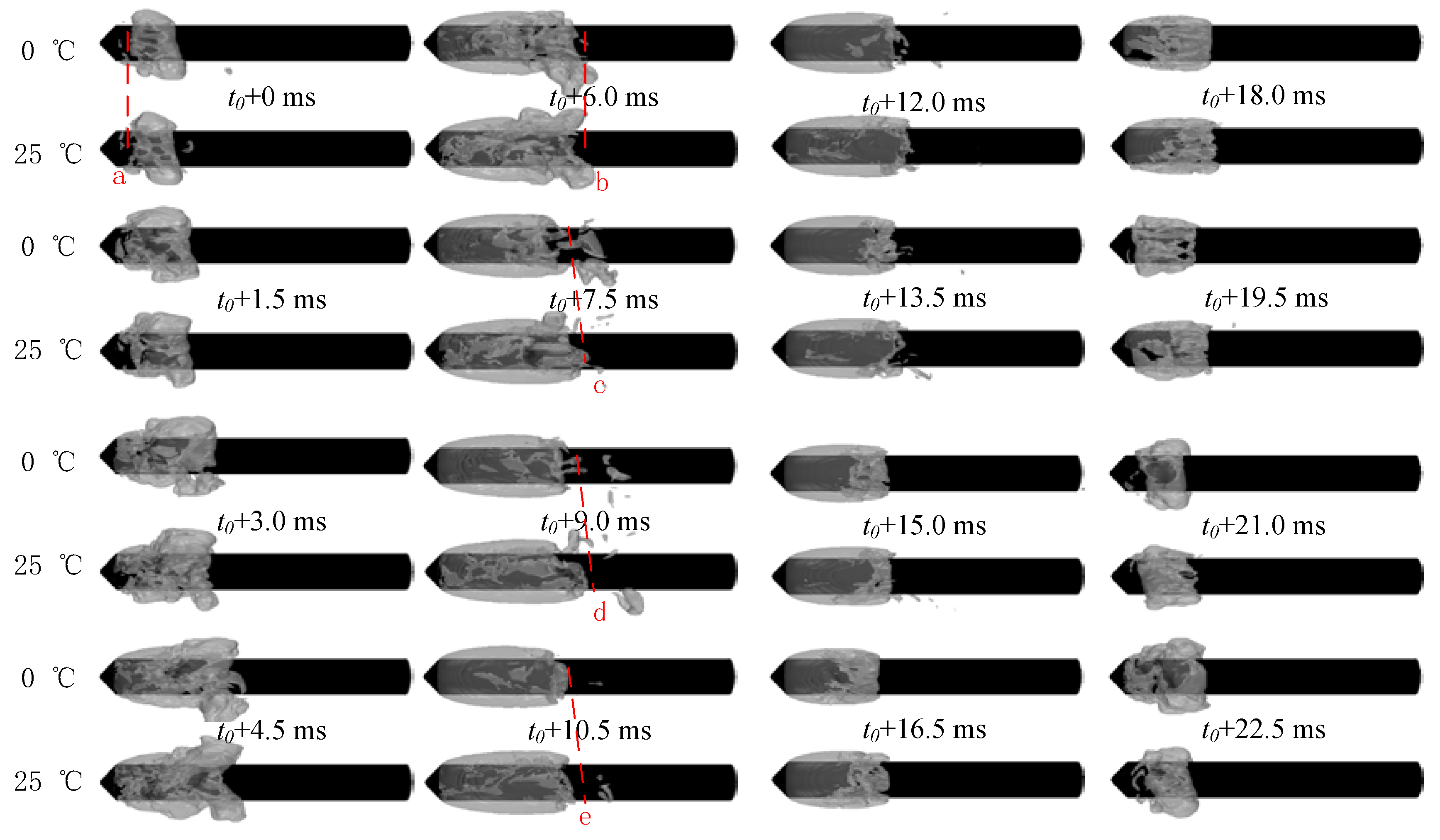
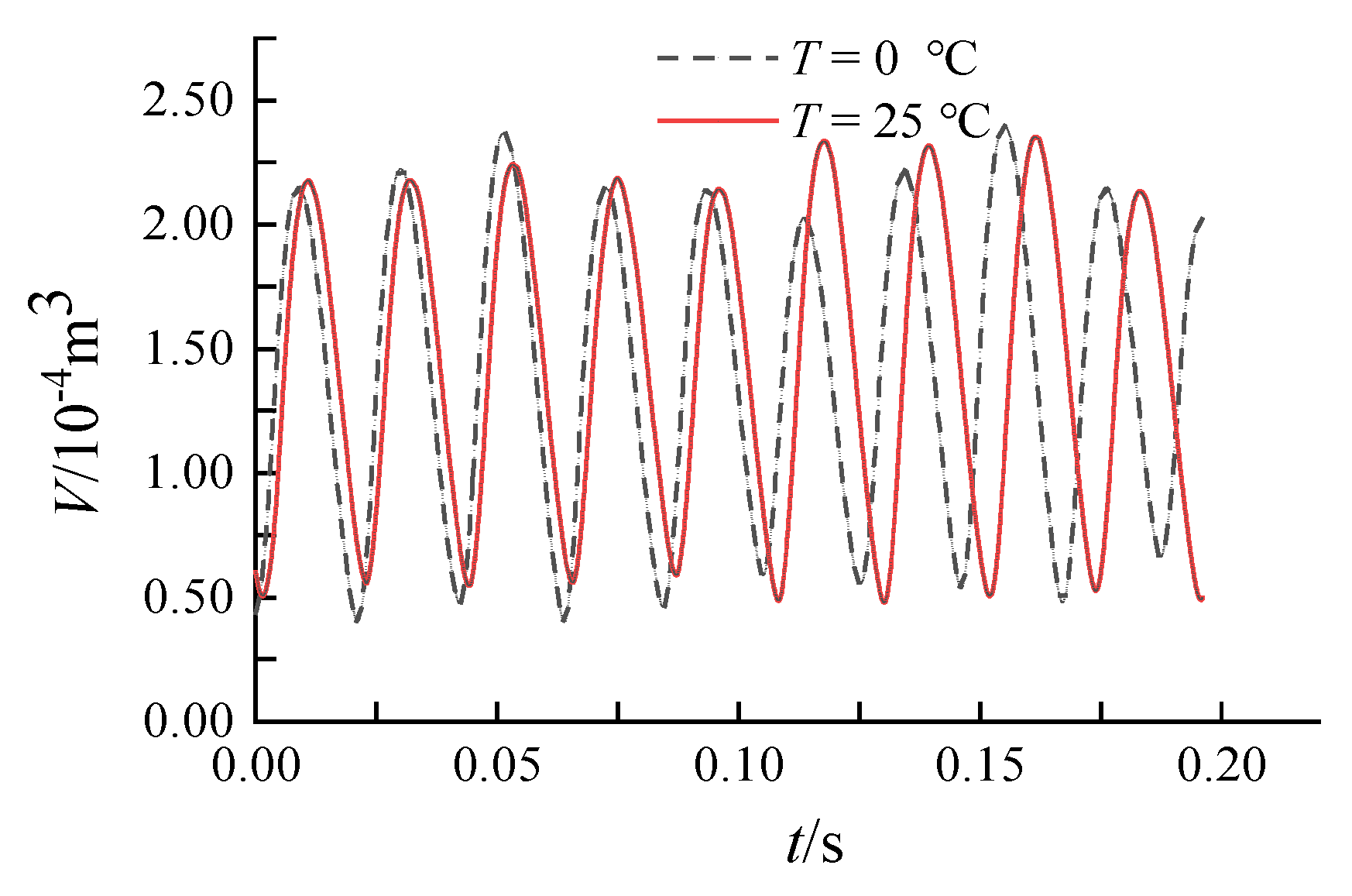

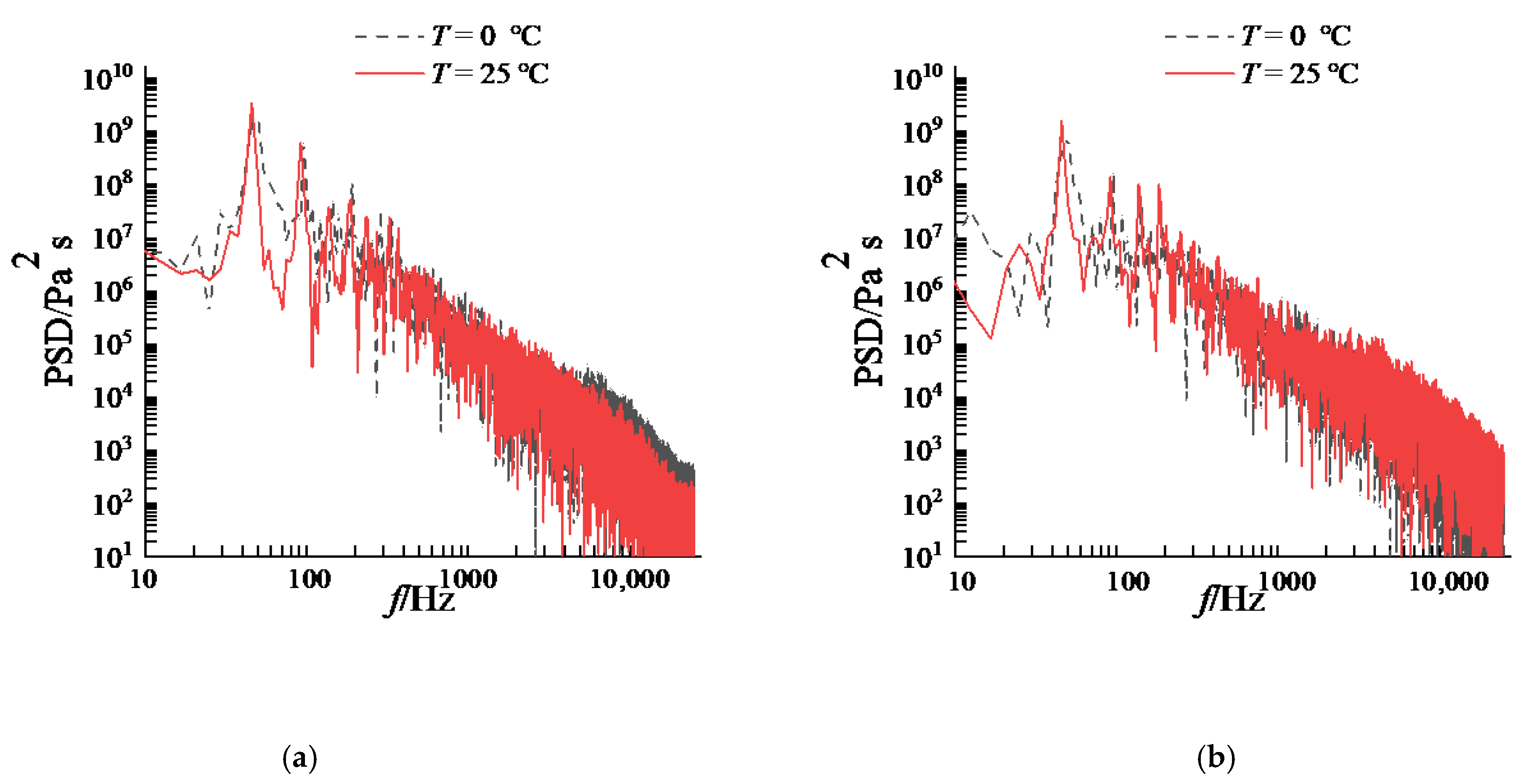
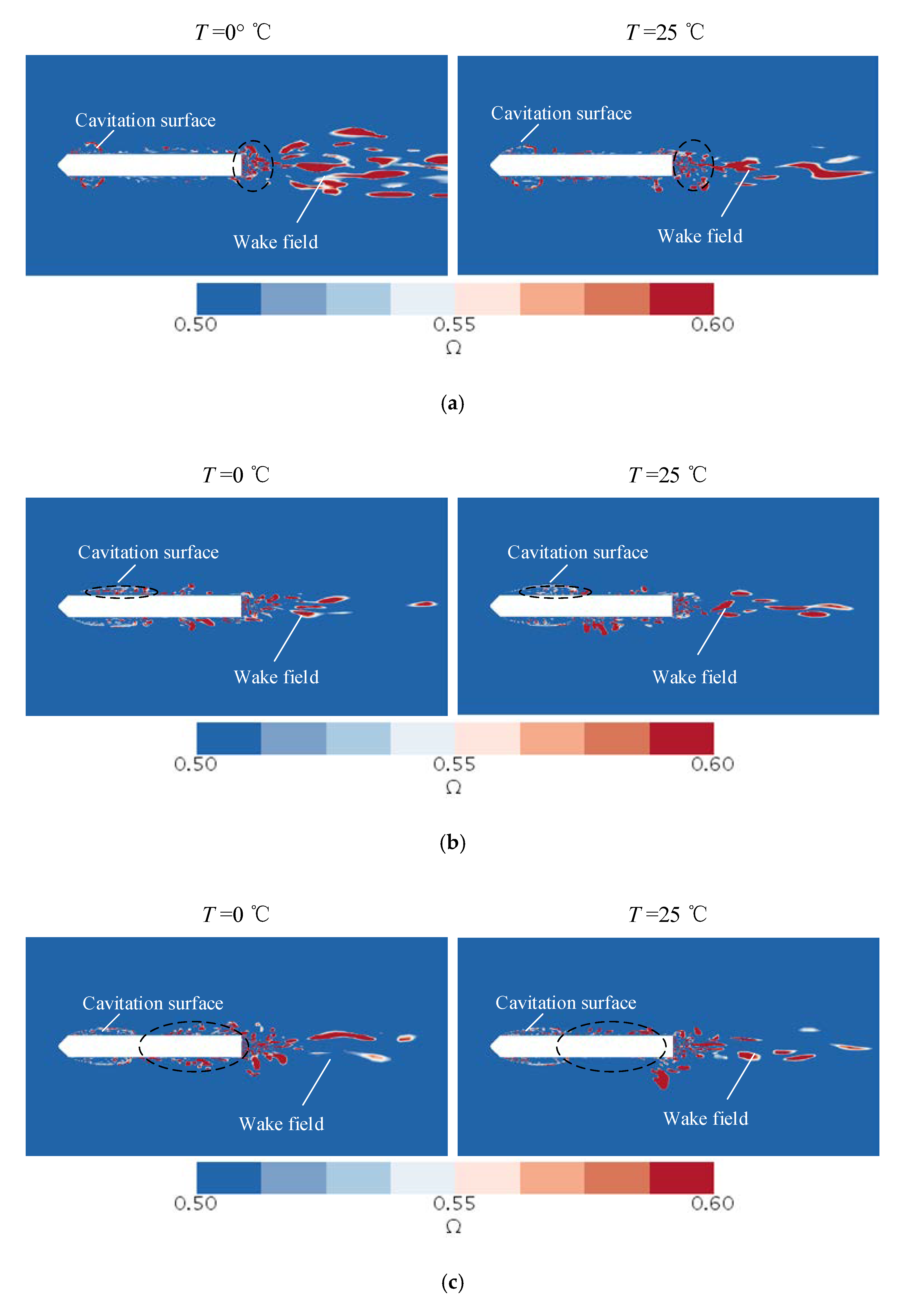
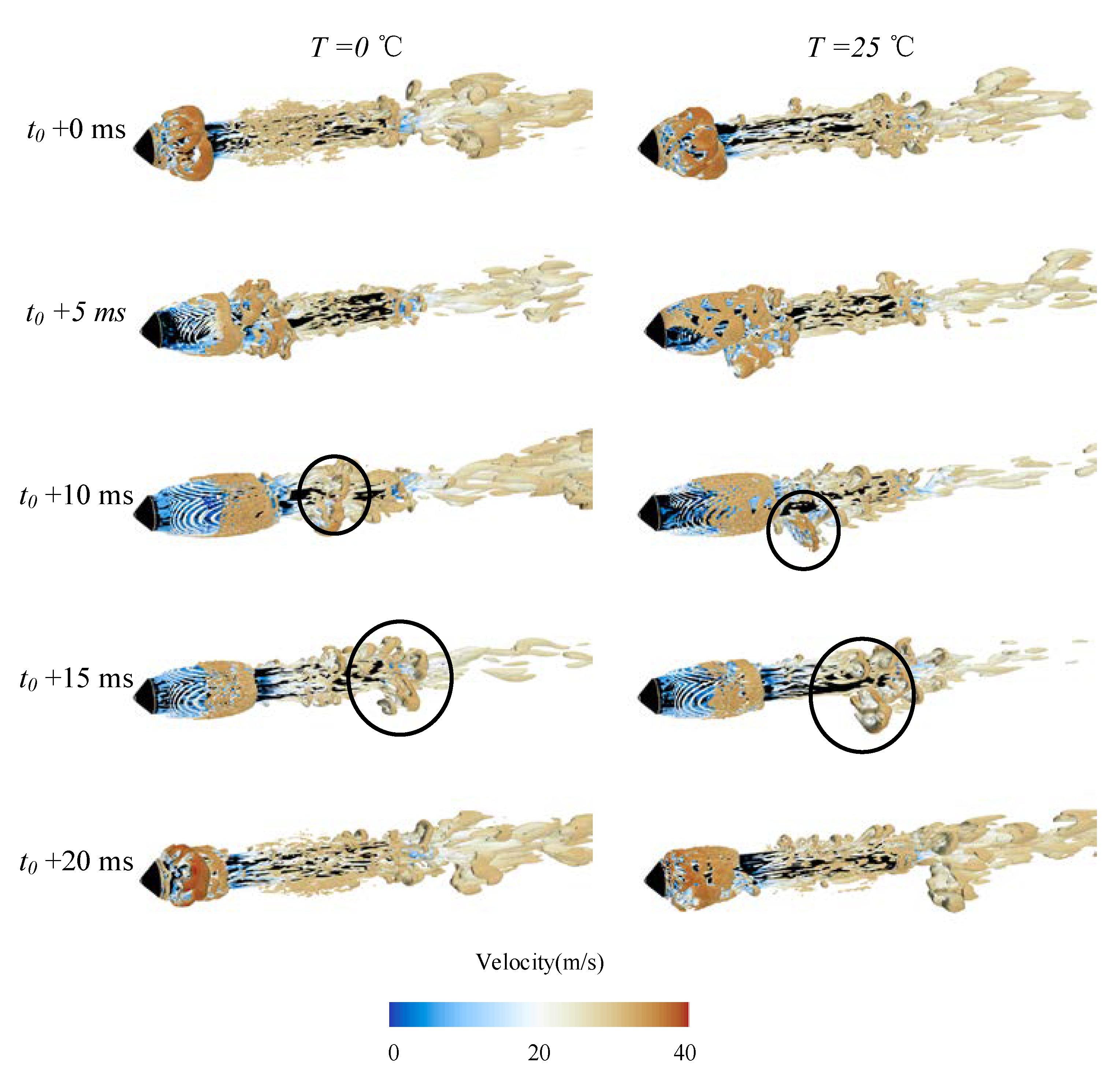


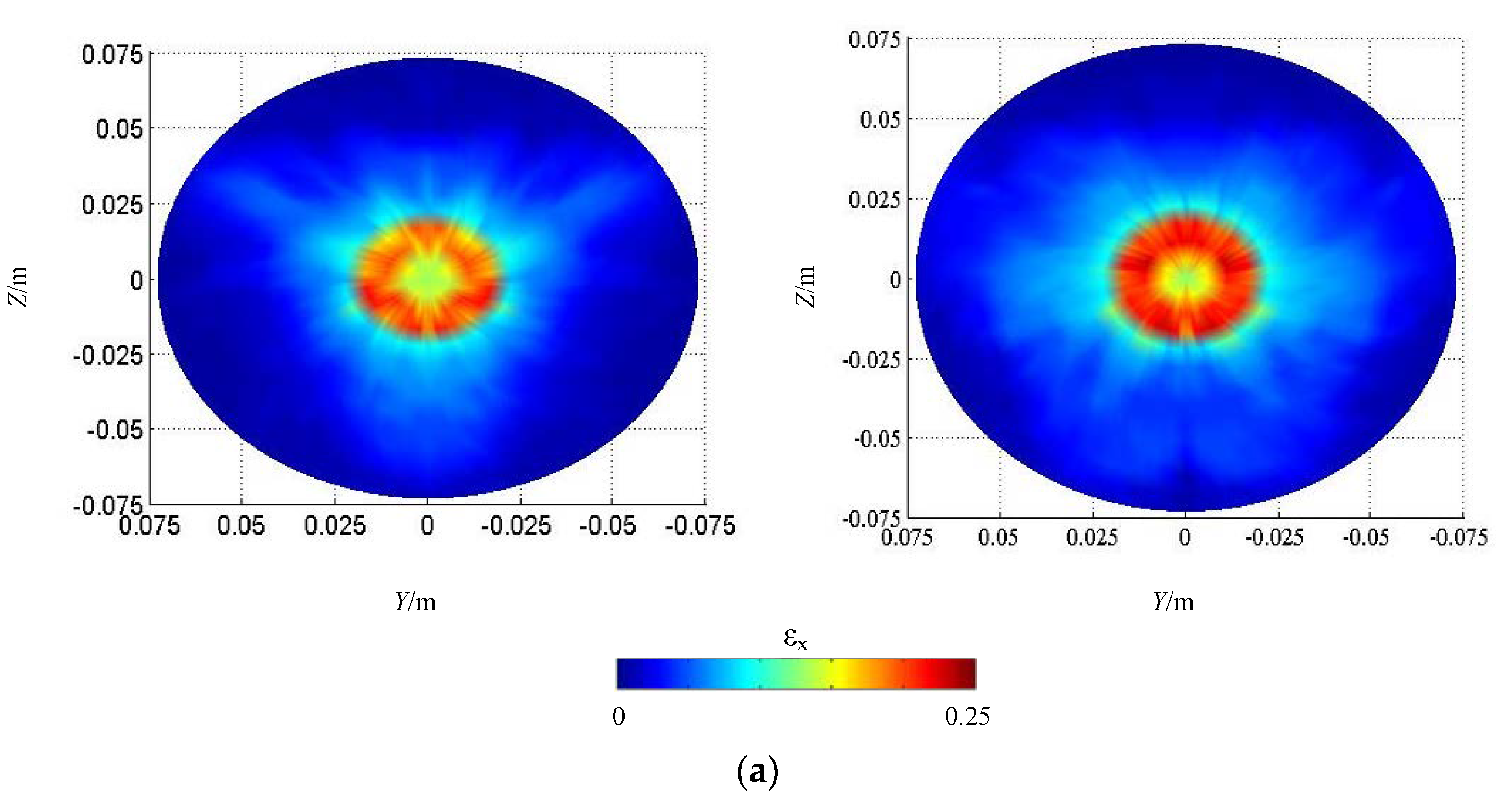
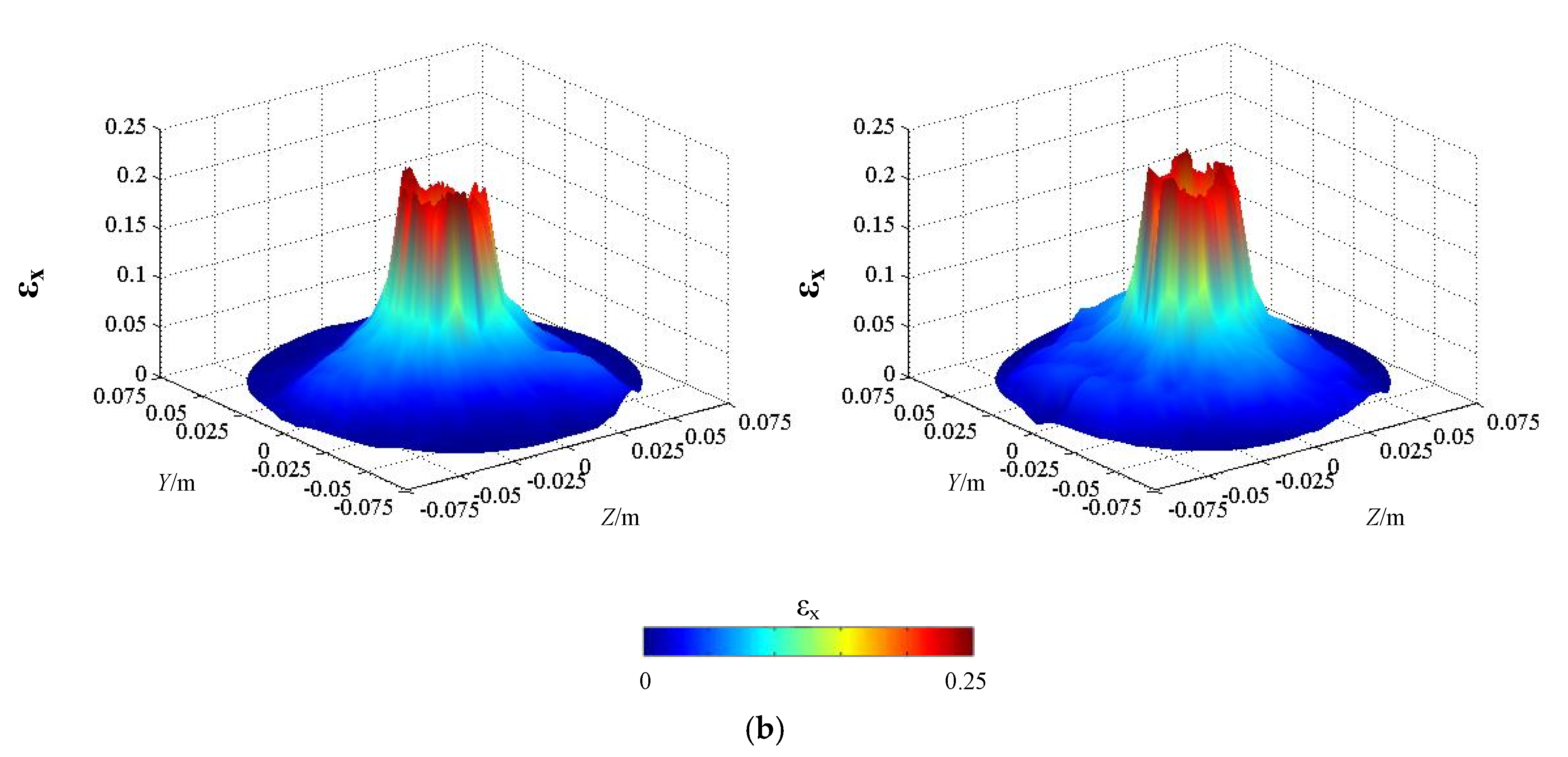
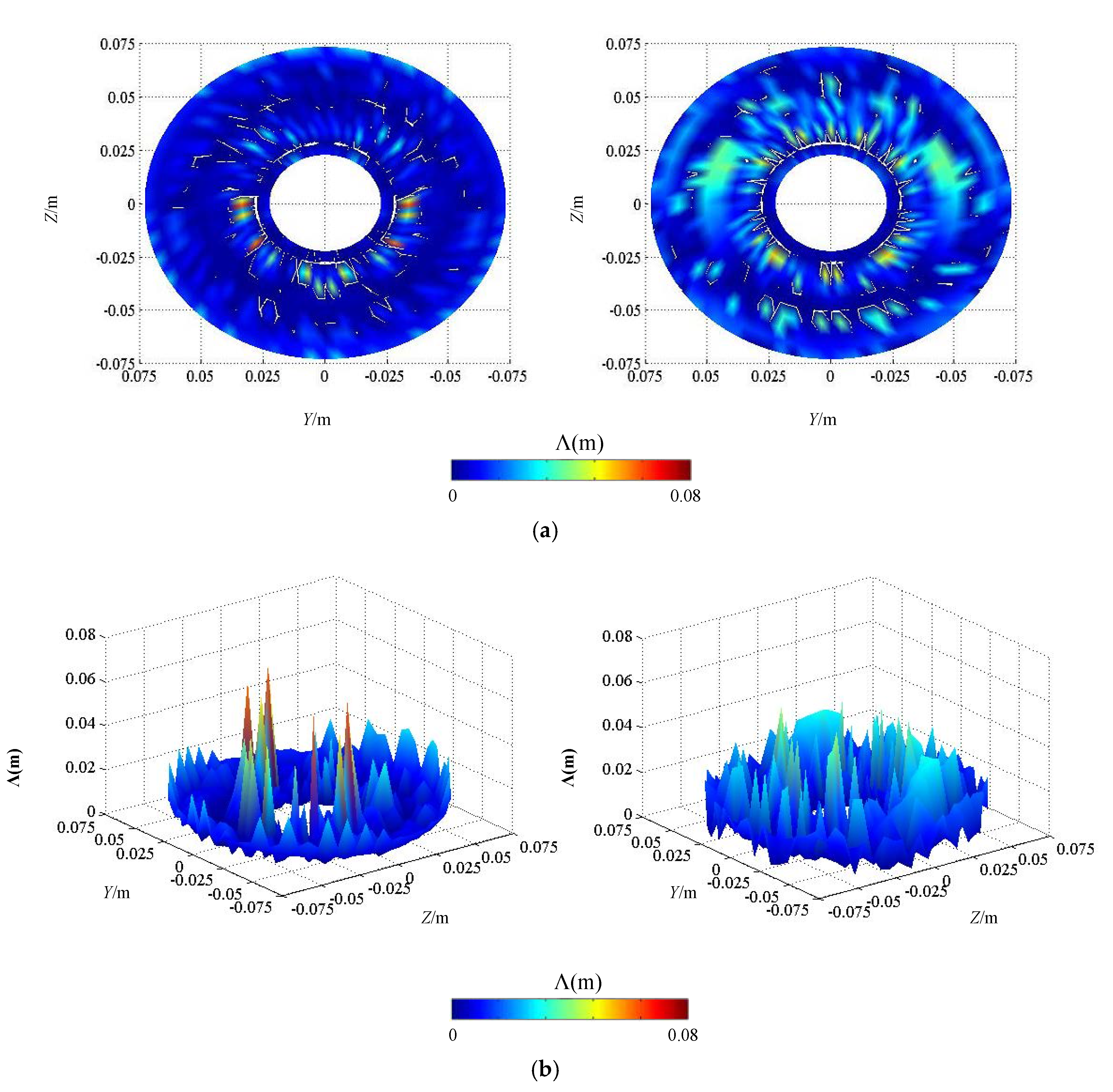

Publisher’s Note: MDPI stays neutral with regard to jurisdictional claims in published maps and institutional affiliations. |
© 2020 by the authors. Licensee MDPI, Basel, Switzerland. This article is an open access article distributed under the terms and conditions of the Creative Commons Attribution (CC BY) license (http://creativecommons.org/licenses/by/4.0/).
Share and Cite
Sun, T.; Zhang, J.; Zhang, X.; Jiang, Y. Study on the Influence of Temperature on the Temporal and Spatial Distribution Characteristics of Natural Cavitating Flow around a Vehicle. J. Mar. Sci. Eng. 2021, 9, 24. https://doi.org/10.3390/jmse9010024
Sun T, Zhang J, Zhang X, Jiang Y. Study on the Influence of Temperature on the Temporal and Spatial Distribution Characteristics of Natural Cavitating Flow around a Vehicle. Journal of Marine Science and Engineering. 2021; 9(1):24. https://doi.org/10.3390/jmse9010024
Chicago/Turabian StyleSun, Tiezhi, Jianyu Zhang, Xiaoshi Zhang, and Yichen Jiang. 2021. "Study on the Influence of Temperature on the Temporal and Spatial Distribution Characteristics of Natural Cavitating Flow around a Vehicle" Journal of Marine Science and Engineering 9, no. 1: 24. https://doi.org/10.3390/jmse9010024



